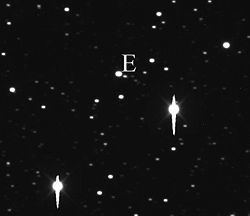Discovered by H. Goldschmidt Pronunciation /jʊˈroʊpə/ ew-ROH-pə Minor planet category Main belt Perihelion 416.63043 billion m Orbits Sun | Discovery date February 4, 1858 Alternative names 1948 LA Aphelion 3.417 AU (511.201 Gm) Discovered 4 February 1858 | |
 | ||
Similar Hermann Goldschmidt discoveries, Other celestial objects | ||
Asteroid 52 europa large vid avi
52 Europa is the 6th-largest asteroid in the asteroid belt, having an average diameter of around 315 km. It is not round but is shaped like a triaxial ellipsoid of approximately 380x330x250 km. It was discovered on February 4, 1858, by Hermann Goldschmidt from his balcony in Paris. It is named after Europa, one of Zeus's conquests in Greek mythology, a name it shares with Jupiter's moon Europa.
Contents
Physical characteristics
Europa is approximately the sixth largest asteroid by volume. Most likely it has a density of around 1.5 g/cm³, typical of C-type asteroids. In 2007, James Baer and Steven R. Chesley estimated Europa to have a mass of (1.9±0.4)×1019 kg. A more recent estimate by Baer suggests it has a mass of 3.27×1019 kg.
Europa is a very dark carbonaceous C-type, and is the second largest of this group. Spectroscopic studies have found evidence of olivines and pyroxenes on the surface, and there is some indication that there may be compositional differences between different regions It orbits close to the Hygiea asteroid family, but is not a member.
Lightcurve data for Europa have been particularly tricky to interpret, so much so that for a long time its period of rotation was in dispute (ranging from 5 and a half hours to 11 hours), despite numerous observations. It has now been determined that Europa is a prograde rotator, but the exact direction in which its pole points remains ambiguous. The most detailed analysis indicates that it points either towards about ecliptic coordinates (β, λ) = (70°, 55°) or (40°, 255°) with a 10° uncertainty. This gives an axial tilt of about 14° or 54°, respectively.
In 1988 a search for satellites or dust orbiting this asteroid was performed using the UH88 telescope at the Mauna Kea Observatories, but the effort came up empty.
Observations
It has been found that the reputed cataclysmic variable star CV Aquarii, discovered in 1934, was actually a misidentification of 52 Europa.
